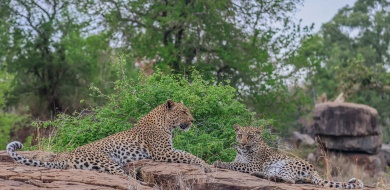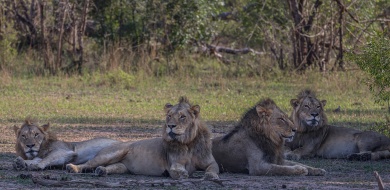A Week in the Bush Vol. 569
on Oct 28, 2025It’s always a privilege to spend time with cheetahs, especially the awe-inspiring Makatini female and her subadults.
Not long after leaving Bush Lodge, we found fresh tracks and followed them to a nearby open area. There, we watched as the youngsters played energetically in the background while their vigilant mother kept a careful eye on her surroundings.




Every sighting on safari is unique, although some encounters undoubtedly bring more excitement than others.
On our morning drive, we came across the young subadult male of the Golonyi female leopard. He was perched high in the branches of a tall marula tree, looking unsettled and visibly anxious. His distress was well-founded — a troop of baboons below had spotted him and were making a commotion, shouting and jeering from the rocks.
For a solitary leopard, especially a young and inexperienced one, a troop of baboons poses a serious threat. Their numbers and aggression can easily overwhelm even the most agile feline.



The Khulwana male continues to mature into a formidable and striking leopard, steadily asserting his dominance within the region. His muscular build, confident stride, and increasing scent-marking activity all signal a young male on the rise — one carving out a territory and staking his claim among the seasoned rivals around him.


When lions make a kill, they typically clamp their jaws around the prey’s throat to crush the windpipe or cover the nose and mouth to block the airway. This method prevents the victim from injuring the lion during the struggle or escaping, and it is the quick, efficient technique lions most often rely on when hunting.
In this sighting, however, there were no signs of suffocation - no claw or bite marks around the mouth, nose, or neck of the giraffe. This suggested that the animal may have died from another cause.
Upon closer examination of the area around the carcass, we noticed that one of the giraffe’s legs was caught in the branches of a small fallen tree nearby. It appeared that the giraffe may have stepped over the tree while feeding, become trapped, lost its balance, and fallen. For an adult giraffe of that size, such a fall - hitting the ground with considerable speed and force - could easily result in a broken neck, loss of consciousness, and ultimately death.







Following the distant roars, we located the Styx male and a Kambula lioness resting in an open clearing not far from Earth Lodge. The male’s keen interest in the female’s scent suggests that mating could soon begin between the two. His deep, resonant calls not only announce his presence but also assert his dominance — a powerful display of confidence that reinforces his status within the area.




We encountered Golonyi’s male cub resting beside the road, bathed in the warm afternoon light. Still refining his skills as a solitary hunter, he reacted to every rustle and bird alarm with sharp, alert eyes — a perfect example of how finely attuned a leopard’s senses are to its surroundings. As the sun began to sink, he rose and slipped soundlessly into the nearby thickets — the master of stealth returning to the shadows where leopards thrive best.


We came across the four young N’waswishaka male lions resting side by side in the early morning light, their heavy breathing a reminder of the heat already settling over the land. Lions are most active during the cool hours of night, conserving their strength by sleeping through the day. As the temperature rises, these powerful cats depend on shade and stillness to stay cool — waiting for dusk to bring relief and another chance to patrol and hunt.





Out of the water, crocodiles appear slow and sluggish, but they are still capable of surprising bursts of speed on land, especially over short distances. They often bask in the sun to regulate their body temperature, as they are cold-blooded reptiles. On land, crocodiles may look less threatening, but they remain dangerous and alert, especially if they feel threatened or are guarding a nest. Their strong limbs and muscular tails help them move across muddy banks or river edges, where they often rest between hunting sessions.


After the Talamati and Nkuhuma male lions abandoned their kill, the vultures quickly swooped in to claim what remained of the feast. While watching them, we noticed a clear hierarchy among the scavengers: the larger White-backed Vultures dominated the smaller Hooded Vultures, aggressively chasing them away from the carcass. This pecking order is largely determined by size - and by the power and shape of each species’ beak.
The White-backed Vultures, equipped with strong, hooked beaks, tore away at the soft tissue clinging to the buffalo’s ribcage. Yet even their impressive tools have limits; their beaks aren’t strong enough to pierce the tough hide of a buffalo. For that, they rely on the work of others - either the formidable Lappet-faced Vultures, whose powerful bills can open the carcass, or the lions themselves, who make the initial kill and expose the flesh beneath.


Two young giraffe bulls spar playfully, testing their strength and skill in a display of dominance. These bouts, known as 'necking', help them build muscle, balance, and confidence - important lessons for future battles over mates.


We observed a small herd of elephant bulls resting quietly in the shade, finding respite from the rising heat of the day. These mature males often form loose bachelor groups, spending their time feeding and conserving energy during the warmer hours. Their calm presence serves as a gentle reminder of the elephants’ intelligence and the enduring social bonds that persist even beyond their family herds.

Until next time…

Blog by Wendy Claase
Images by Jan Nel, Jana du Plessis, Ronald Mutero and Ruan Mey







